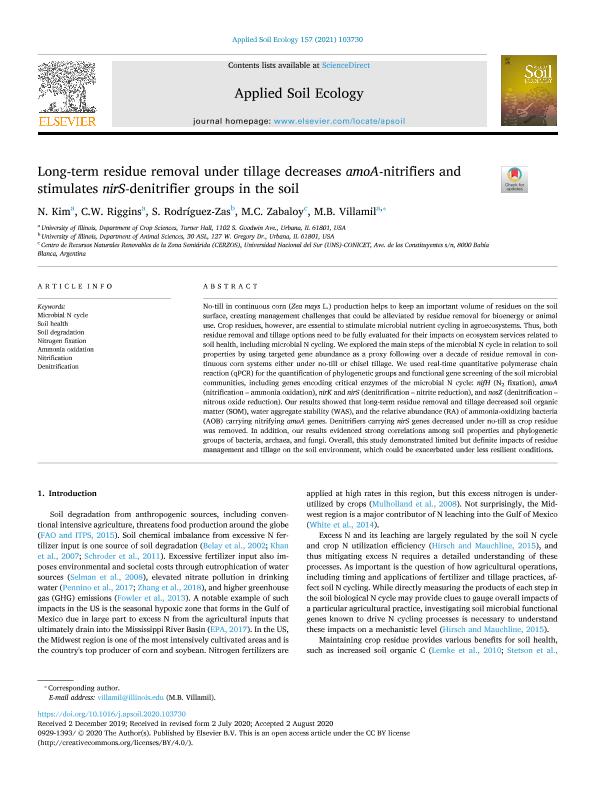Mostrar el registro sencillo del ítem
dc.contributor.author
Kim, N.
dc.contributor.author
Riggins, C. W.
dc.contributor.author
Rodríguez Zas, S.
dc.contributor.author
Zabaloy, Maria Celina

dc.contributor.author
Villamil, Maria Bonita

dc.date.available
2021-06-28T18:03:44Z
dc.date.issued
2021-01
dc.identifier.citation
Kim, N.; Riggins, C. W.; Rodríguez Zas, S.; Zabaloy, Maria Celina; Villamil, Maria Bonita; Long-term residue removal under tillage decreases amoA-nitrifiers and stimulates nirS-denitrifier groups in the soil; Elsevier Science; Applied Soil Ecology; 157; 1-2021; 1-8; 103730
dc.identifier.issn
0929-1393
dc.identifier.uri
http://hdl.handle.net/11336/135050
dc.description.abstract
No-till in continuous corn (Zea mays L.) production helps to keep an important volume of residues on the soil surface, creating management challenges that could be alleviated by residue removal for bioenergy or animal use. Crop residues, however, are essential to stimulate microbial nutrient cycling in agroecosystems. Thus, both residue removal and tillage options need to be fully evaluated for their impacts on ecosystem services related to soil health, including microbial N cycling. We explored the main steps of the microbial N cycle in relation to soil properties by using targeted gene abundance as a proxy following over a decade of residue removal in continuous corn systems either under no-till or chisel tillage. We used real-time quantitative polymerase chain reaction (qPCR) for the quantification of phylogenetic groups and functional gene screening of the soil microbial communities, including genes encoding critical enzymes of the microbial N cycle: nifH (N2 fixation), amoA (nitrification – ammonia oxidation), nirK and nirS (denitrification – nitrite reduction), and nosZ (denitrification – nitrous oxide reduction). Our results showed that long-term residue removal and tillage decreased soil organic matter (SOM), water aggregate stability (WAS), and the relative abundance (RA) of ammonia-oxidizing bacteria (AOB) carrying nitrifying amoA genes. Denitrifiers carrying nirS genes decreased under no-till as crop residue was removed. In addition, our results evidenced strong correlations among soil properties and phylogenetic groups of bacteria, archaea, and fungi. Overall, this study demonstrated limited but definite impacts of residue management and tillage on the soil environment, which could be exacerbated under less resilient conditions.
dc.format
application/pdf
dc.language.iso
eng
dc.publisher
Elsevier Science

dc.rights
info:eu-repo/semantics/openAccess
dc.rights.uri
https://creativecommons.org/licenses/by/2.5/ar/
dc.subject
AMMONIA OXIDATION
dc.subject
DENITRIFICATION
dc.subject
MICROBIAL N CYCLE
dc.subject
NITRIFICATION
dc.subject
NITROGEN FIXATION
dc.subject
SOIL DEGRADATION
dc.subject
SOIL HEALTH
dc.subject.classification
Ciencias del Suelo

dc.subject.classification
Agricultura, Silvicultura y Pesca

dc.subject.classification
CIENCIAS AGRÍCOLAS

dc.title
Long-term residue removal under tillage decreases amoA-nitrifiers and stimulates nirS-denitrifier groups in the soil
dc.type
info:eu-repo/semantics/article
dc.type
info:ar-repo/semantics/artículo
dc.type
info:eu-repo/semantics/publishedVersion
dc.date.updated
2021-06-10T19:27:03Z
dc.journal.volume
157
dc.journal.pagination
1-8; 103730
dc.journal.pais
Países Bajos

dc.journal.ciudad
Amsterdam
dc.description.fil
Fil: Kim, N.. University of Illinois; Estados Unidos
dc.description.fil
Fil: Riggins, C. W.. University of Illinois; Estados Unidos
dc.description.fil
Fil: Rodríguez Zas, S.. University of Illinois; Estados Unidos
dc.description.fil
Fil: Zabaloy, Maria Celina. Consejo Nacional de Investigaciones Científicas y Técnicas. Centro Científico Tecnológico Conicet - Bahía Blanca. Centro de Recursos Naturales Renovables de la Zona Semiárida. Universidad Nacional del Sur. Centro de Recursos Naturales Renovables de la Zona Semiárida; Argentina
dc.description.fil
Fil: Villamil, Maria Bonita. Consejo Nacional de Investigaciones Científicas y Técnicas; Argentina. University of Illinois; Estados Unidos
dc.journal.title
Applied Soil Ecology

dc.relation.alternativeid
info:eu-repo/semantics/altIdentifier/url/https://www.sciencedirect.com/science/article/pii/S0929139320306594
dc.relation.alternativeid
info:eu-repo/semantics/altIdentifier/doi/http://dx.doi.org/10.1016/j.apsoil.2020.103730
Archivos asociados
